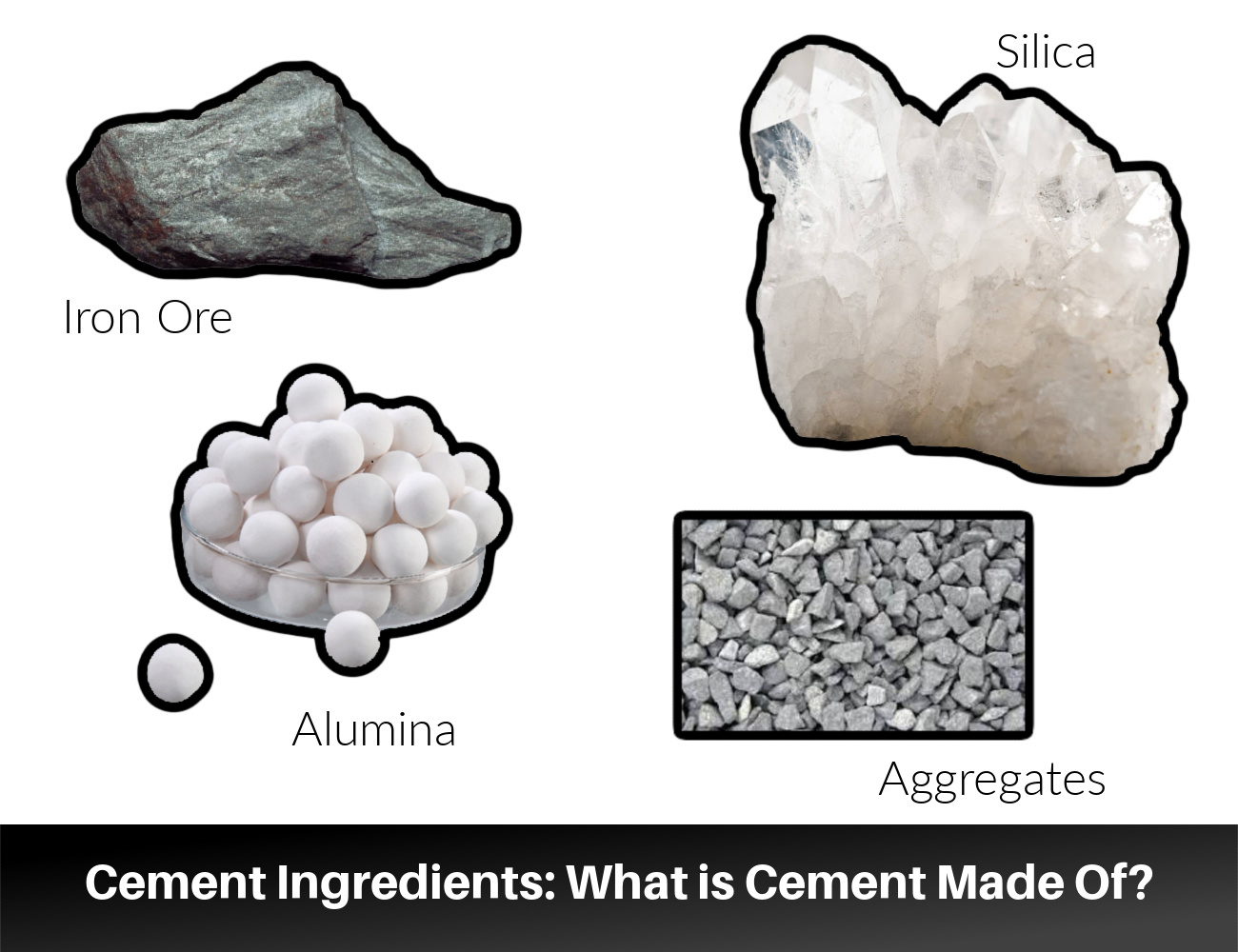Main Cement Ingredients: Their Purpose and Limitations
Cement ingredients are diverse components that blend together to create a strong and durable building material. The raw materials, selected carefully and combined to produce different effects and cement types, are lime, silica, alumina, iron ore, aggregates, gypsum, and supplementary cementitious materials.
Each of these ingredients of cement play a unique role in the chemical reactions and specific qualities of cement. This combination results in a versatile and durable substance that builders have used for centuries and still use today.
Cement Ingredients: What is Cement Made Of?
Cement is a mixture of raw ingredients that are designed to produce a specific type of cement. Each cement ingredient brings particular qualities to the cement. But the introduction of a particular ingredient also features limitations that make the cement function in a distinct way.
Lime
Limestone is a sedimentary rock that is composed primarily of calcium carbonate in the form of calcite. Limestone is an abundant natural resource and its versatility, abundance, and aesthetic qualities have made it a valuable resource. For centuries, people have used limestone as a building material, soil conditioner, and raw ingredient in other products.
Limestone is a valuable raw ingredient in cement because it provides calcium. This is essential in the chemical reactions that occur during the hydration process in cement. Calcium reacts with water to form calcium silicate hydrate gel which helps cement to harden and gain strength. Lime also serves as a retarder, slowing down the set time of the cement.
The quality of lime will vary from source to source. Some lime will feature excessive amounts of impurities which affects the quality of the cement product. It is also vital to determine the correct quantity of lime in the cement mixture. Too much lime will increase setting time and decrease strength. Too little lime will cause rapid setting times and may increase the susceptibility to sulfate attacks.
Silica
Silica is a naturally occurring compound and one of the most abundant in the Earth’s crust. Cement manufacturers derive silica from natural resources like clay and shale.
Silica reacts with limestone to form compounds that are responsible for the strength of cement. Silica also contributes to the hydraulic qualities of cement and helps it to harden when mixed with water.
When making cement, manufacturers must control the amounts of silica to produce cement with desired results. An excess of silica can delay strength development and will require additional curing time. Too much silica can also increase shrinkage in the cement leading to cracks that develop during the drying state.
Alumina
Alumina, or aluminum oxide, is derived from bauxite. Bauxite is a clay-like mineral that is rich in aluminum.
Alumina helps cement to set more quickly and improves sulfate resistance. It also helps cement to produce heat during hydration which is important in helping cement set in cold weather conditions
Too much alumina can cause the cement to set too quickly, making it challenging to use. Excessive amounts of alumina can cause quick short-term strength but reduced long-term durability of cement.
Iron Ore
Iron ore is rock or minerals that contain metallic iron. Iron ore contains iron oxides like hematite and magnetite, which are important ingredients in cement.
Iron ore acts as a coloring agent in cement. It can create shades of red, brown, and black cement, contributing to the aesthetic appeal. Iron ore also acts as a fluxing agent to reduce the melting point of raw ingredients. This helps them to fuse more effectively.
Impurities such as sulfur or phosphorus present in iron ore will cause the strength, durability, and workability of cement to suffer.
Aggregates
Aggregates are granular materials that cement producers add to the cement mixture. They provide a majority of the volume in the mixture and provide bulk, strength, and stability. Common aggregates in cement are sand, gravel, crushed stone, recycled concrete aggregate (RCA), and lightweight aggregates such as expanded clay, shale, or slate.
The interlocking nature of aggregates contributes to cement’s overall strength and load-bearing capacity. They help to control the shrinkage in cement during the drying and curing process. The addition of aggregates also helps to keep the cost of cement lower.
Aggregates increase the need for extra water to ensure good workability for the cement. Certain aggregates can also cause an alkali-silica reaction with the alkaline components in the cement paste which can cause cracking, expansion, and deterioration in the cement over time.
Gypsum
Gypsum is a mineral composed of calcium sulfate dihydrate and is a common additive in cement. Gypsum acts as a retarder in cement, slowing down the initial setting time. This quality allows workers better workability and extended placement. The addition of gypsum helps prevent the quick hardening of cement when it comes into contact with water and protects the cement from deterioration in sulfur-rich environments.
Too much gypsum can lead to delayed strength development. Manufacturers must also consider the exact chemical composition of their specific cement ingredients as gypsum can react with certain chemicals in the mixture and degrade the cement’s performance and properties.
Supplementary Cementitious Materials (SCM)
In addition to the standard ingredients for cement, there are cementitious materials that some cements contain. These materials include fly ash, silica fume, pozzolans, and slag.
The SCMs provide many benefits in cement. They help to improve the workability, cohesiveness, strength, and durability as well as reduce the permeability and temperature development in cement. The introduction of SCMs also helps improve the environmental benefits of a particular type of cement. Many SCMs are by-products of the cement industry that would go into landfills unless crushed to become part of cement. They also help to reduce the need for raw cement production.
In some cases, SCMs are associated with delayed strength development in cement. SCMs are available in different compositions and particle sizes, so they can vary according to the qualities they produce. Cement producers must carefully select SCMs to produce cement with the desired qualities.

